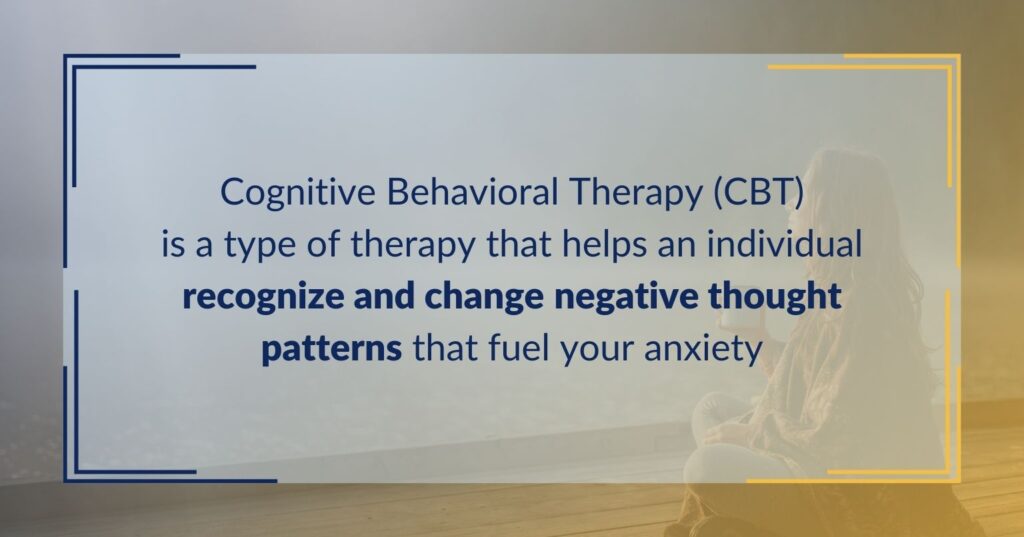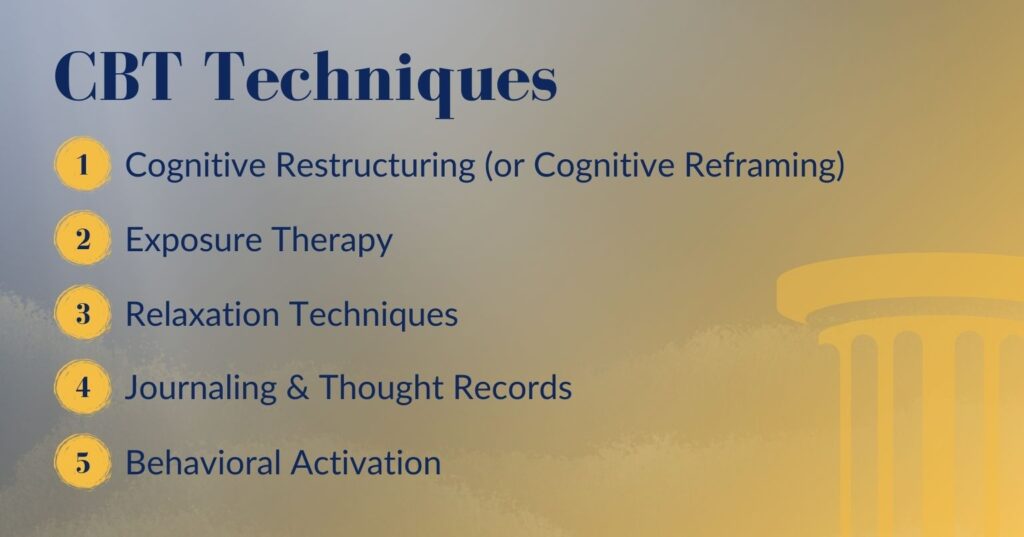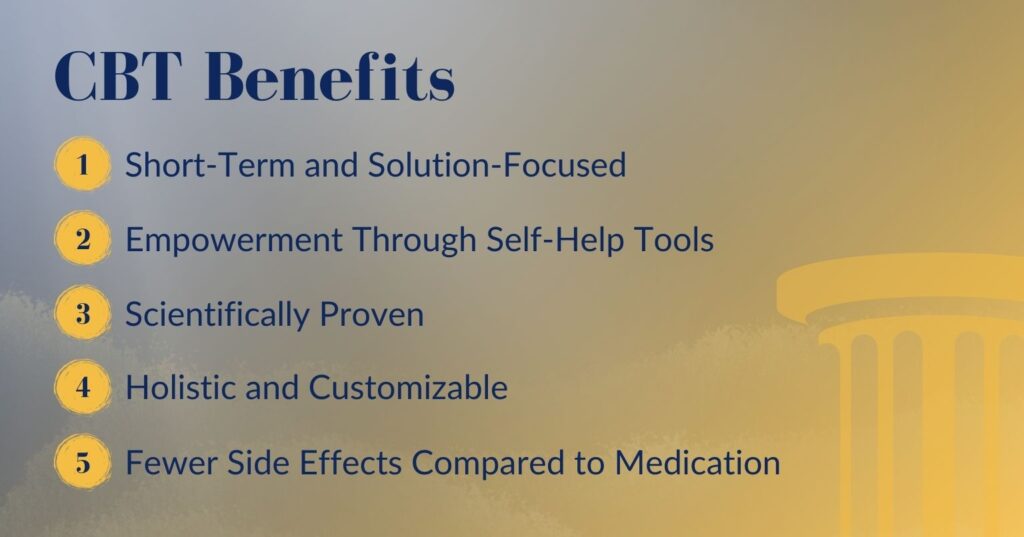
Have you ever felt like anxiety is running your life? From sleepless nights to racing thoughts, anxiety can leave feelings of being trapped and overwhelmed. The good news is that Cognitive Behavioral Therapy (CBT) offers a way to regain control.
With proven strategies and practical tools, CBT helps you challenge negative thought patterns and reduce anxiety’s grip on your mind. Whether you’re dealing with constant worry, panic attacks, or stress that won’t seem to fade, CBT can empower you to take back your life—one step at a time.
How CBT Works for Anxiety Management
Anxiety often feels like an invisible weight pressing down—one that clouds your thoughts, disturbs your sleep, and interferes with your daily life. But what if there was a way to lift that weight and regain a sense of control? That’s where Cognitive Behavioral Therapy (CBT) comes in.
CBT is a type of therapy that helps an individual recognize and change the negative thought patterns that fuel your anxiety. By understanding how your thoughts affect your feelings and behaviors, you can begin to learn how to break free from the cycle of anxiety.

- Identifying Negative Thoughts: Anxiety often stems from distorted thinking—catastrophizing events, assuming the worst, or overgeneralizing from one bad experience. In CBT, you’ll work with your therapist to pinpoint these negative thoughts that drive your anxiety.
- Challenging and Restructuring Thoughts: Once you’ve identified these unhelpful thoughts, the next step is learning how to challenge them. Is that worst-case scenario really as likely as you think? CBT helps you replace these anxiety-provoking thoughts with more realistic, balanced thinking.
- Practical Tools for Managing Anxiety: CBT equips you with practical tools like mindfulness exercises, breathing techniques, and gradual exposure to anxiety-inducing situations. These tools can be practiced both in therapy and in your daily life, giving you the power to manage anxiety as it arises.
With Cognitive Behavioral Therapy, you’re not just talking about your anxiety—you’re actively working to understand, manage, and overcome it. By learning to restructure negative thoughts and incorporate practical coping strategies, you can find lasting relief from anxiety and start living a more balanced life.
Common CBT Techniques for Managing Anxiety
CBT offers a wide array of techniques designed to help manage anxiety, and the best part is, many of them are practical and can be applied outside of therapy sessions. Below are some of the most effective CBT techniques that we will employ to reduce anxious feelings:
- Cognitive Restructuring (or Cognitive Reframing): This technique helps you identify and challenge irrational or negative thoughts that contribute to anxiety. For example, if you constantly think, “I’m going to fail,” cognitive restructuring helps you question that belief and replace it with a more realistic thought, such as, “I’ve prepared for this, and I’ll do my best.” Over time, this process of questioning negative thoughts weakens anxiety’s grip.
- Exposure Therapy: Anxiety often leads to avoidance—avoiding situations, people, or tasks that trigger stress. However, avoidance tends to reinforce anxiety in the long run. Exposure therapy helps you gradually face these anxiety-inducing situations in a safe and controlled environment. By doing so, your anxiety lessens as you realize that the feared outcome is either unlikely or manageable.
- Relaxation Techniques: Learning to calm various parts of the body is a crucial part of anxiety management. Techniques such as deep breathing exercises, progressive muscle relaxation, and guided imagery are frequently used in CBT to help reduce the physical symptoms of anxiety, like tension and a racing heart. These exercises also give you tools to manage anxiety quickly when it arises.
- Journaling and Thought Records: Writing down your thoughts and emotions can help you recognize patterns in your thinking. During CBT, you might be asked to keep a thought record, where you document situations that trigger anxiety, your reactions, and how you reframed your thoughts afterward. This technique helps you track your progress and notice gradual improvements.
- Behavioral Activation: Anxiety often causes people to withdraw from activities they enjoy or find meaningful. Behavioral activation encourages you to re-engage in these activities, even when anxiety is present. By focusing on doing things that bring joy or fulfillment, you can break the cycle of avoidance and enhance your mood over time.

Each of these techniques empowers you to take an active role in managing your anxiety. They can be practiced both during therapy sessions and in your everyday life, allowing you to gradually build resilience and gain confidence in your ability to cope with stress.
Benefits of CBT Over Other Forms of Therapy
When it comes to managing anxiety, there are various therapeutic approaches available, but Cognitive Behavioral Therapy (CBT) stands out for several reasons. It is widely regarded as one of the most effective and evidence-based treatments for anxiety disorders. Here’s how CBT compares to other types of therapy:
- Short-Term and Solution-Focused: Unlike traditional talk therapies that may last for years, CBT is typically a short-term therapy. Most clients experience significant improvement in their anxiety symptoms after just 12-20 sessions. CBT’s structured, goal-oriented nature helps clients focus on developing practical tools for change, making it an efficient option for those looking for faster results.
- Empowerment Through Self-Help Tools: One of the biggest advantages of CBT is that it empowers you to take control of your anxiety. Instead of relying solely on your therapist, you learn self-help tools that you can apply in your daily life. Techniques like cognitive restructuring and mindfulness teach you how to manage anxiety outside of therapy, giving you long-lasting results.
- Scientifically Proven: CBT is backed by a wealth of research showing its effectiveness for anxiety, depression, and many other mental health issues. Studies have shown that CBT is as effective as medication for anxiety disorders and, in some cases, more effective in preventing relapse. This makes it a trusted option for clients seeking therapy with proven outcomes.
- Holistic and Customizable: CBT is not a one-size-fits-all approach. It is highly adaptable and can be customized to fit your specific needs and challenges. Whether you’re dealing with generalized anxiety, panic disorder, or social anxiety, CBT techniques are flexible and can be tailored to address your unique concerns.
- Fewer Side Effects Compared to Medication: Many people turn to medication to manage their anxiety, but medications often come with side effects such as drowsiness, weight gain, or dependency. Some anti-anxiety medications can also intensify the symptoms they are trying to reduce. In contrast, CBT has no physical side effects and provides long-term coping strategies that remain effective long after therapy ends. It’s a natural, skill-building approach that enhances your mental well-being.

CBT helps you achieve lasting change by focusing on actionable steps and clearly understanding your thought processes. If you’re looking for a therapy that offers practical tools, scientific support, and real-world application, CBT could be the ideal choice for you.
Frequently Asked Questions about CBT for Anxiety
When considering Cognitive Behavioral Therapy (CBT) for anxiety, it’s natural to have a few questions. Here are some common FAQs to help clarify what CBT is, how it works, and what to expect:
1. What is Cognitive Behavioral Therapy (CBT), and how does it work?
CBT is a form of psychotherapy that helps people manage their anxiety by changing the way they think and behave. The therapy focuses on identifying negative thought patterns and developing healthier responses to stress and anxiety-inducing situations. Through structured sessions, you’ll learn techniques like cognitive restructuring, which involves challenging unhelpful thoughts, and behavioral activation, which encourages re-engaging in activities that you may be avoiding due to anxiety.
2. How can CBT help with anxiety?
CBT teaches clients how to identify distorted thinking and challenge these irrational thoughts. For example, if your anxiety stems from a fear of failure, CBT will help you identify the unrealistic thoughts driving that fear and replace them with more rational, balanced thinking. Over time, these techniques help reduce the intensity of anxiety symptoms and improve your ability to cope with stressful situations.
3. How long does CBT for anxiety typically last?
CBT is usually a short-term therapy, with most people experiencing noticeable improvements after 12-20 sessions. However, the exact length of treatment depends on your individual needs and the severity of your anxiety. Some may benefit from a shorter course of therapy, while others may require a bit more time to develop lasting coping strategies.
4. Can CBT be done virtually, or does it require in-person sessions?
CBT can be conducted both in-person and virtually. Many therapists, including those at Pillars of Hope Counseling, offer online CBT sessions for clients who prefer the convenience of therapy from their own home. Virtual CBT has been shown to be just as effective as face-to-face sessions, making it a flexible option for those with busy schedules or transportation challenges.
5. What tools or techniques are used in CBT for managing anxiety?
Some of the most common tools used in CBT for anxiety include:
- Cognitive Restructuring: Reframing negative thoughts into more balanced perspectives.
- Exposure Therapy: Gradually confronting fears to reduce avoidance behaviors.
- Mindfulness Exercises: Techniques such as deep breathing or guided imagery to calm the mind and reduce stress.
- Thought Records: Journaling exercises to track thoughts and behaviors over time, helping to identify triggers and patterns.
- Coping Cards: These are index cards with the concern or fear on one side and then ways to overcome the concern or fear on the other side.
6. How does CBT compare to other forms of therapy for anxiety?
Compared to other therapies, CBT is goal-oriented, practical, and short-term. It focuses on providing clients with the tools they need to manage anxiety in real time. While therapies like psychodynamic therapy explore deeper emotional issues or past experiences, CBT emphasizes changing current thought patterns to improve present-day functioning.
7. What are the side effects of Cognitive Behavioral Therapy?
CBT has minimal side effects. Because it’s a non-invasive form of therapy, the most common “side effects” are temporary emotional discomfort as clients confront their anxious thoughts. However, this discomfort is often a necessary step in the therapeutic process, and it leads to long-term improvement in managing anxiety.
How to Get Started with CBT for Anxiety in Tigard
If you’re struggling with anxiety and are ready to take the first step toward managing it, Cognitive Behavioral Therapy (CBT) could be the right approach for you. At Pillars of Hope Counseling in Tigard, we specialize in helping clients navigate anxiety with practical, evidence-based tools that bring real, lasting relief.
Why Choose CBT at Pillars of Hope Counseling?
When you choose Pillars of Hope Counseling, you’re not just signing up for therapy—you’re partnering with a compassionate, experienced therapist who will work with you every step. Angelie Karabatsos is highly trained in CBT techniques, and she customizes each session to fit your unique needs and challenges.
Whether you’re experiencing generalized anxiety, panic attacks, or stress-related concerns, our personalized approach ensures that you receive the care and attention you deserve.
Personalized Therapy, Tailored For You
No two clients are the same, so we offer tailored CBT programs that focus on your specific symptoms and goals. During your first session, Angelie will work with you to develop a plan that addresses your personal triggers and provides you with actionable tools to start managing your anxiety immediately.
Angelie provides strategies and tools in every session, including the first session. Her goal is to arm her clients with tools each time they meet, so they are empowered.
Get Started Today—Don’t Let Anxiety Hold You Back
Taking the first step can feel daunting, but at Pillars of Hope Counseling, we make it simple and supportive. Whether you prefer in-person sessions or the convenience of virtual therapy, we’re here to help you take control of your mental health and move forward with confidence.
Contact us today to schedule your first session and begin your journey to a calmer, more balanced life.